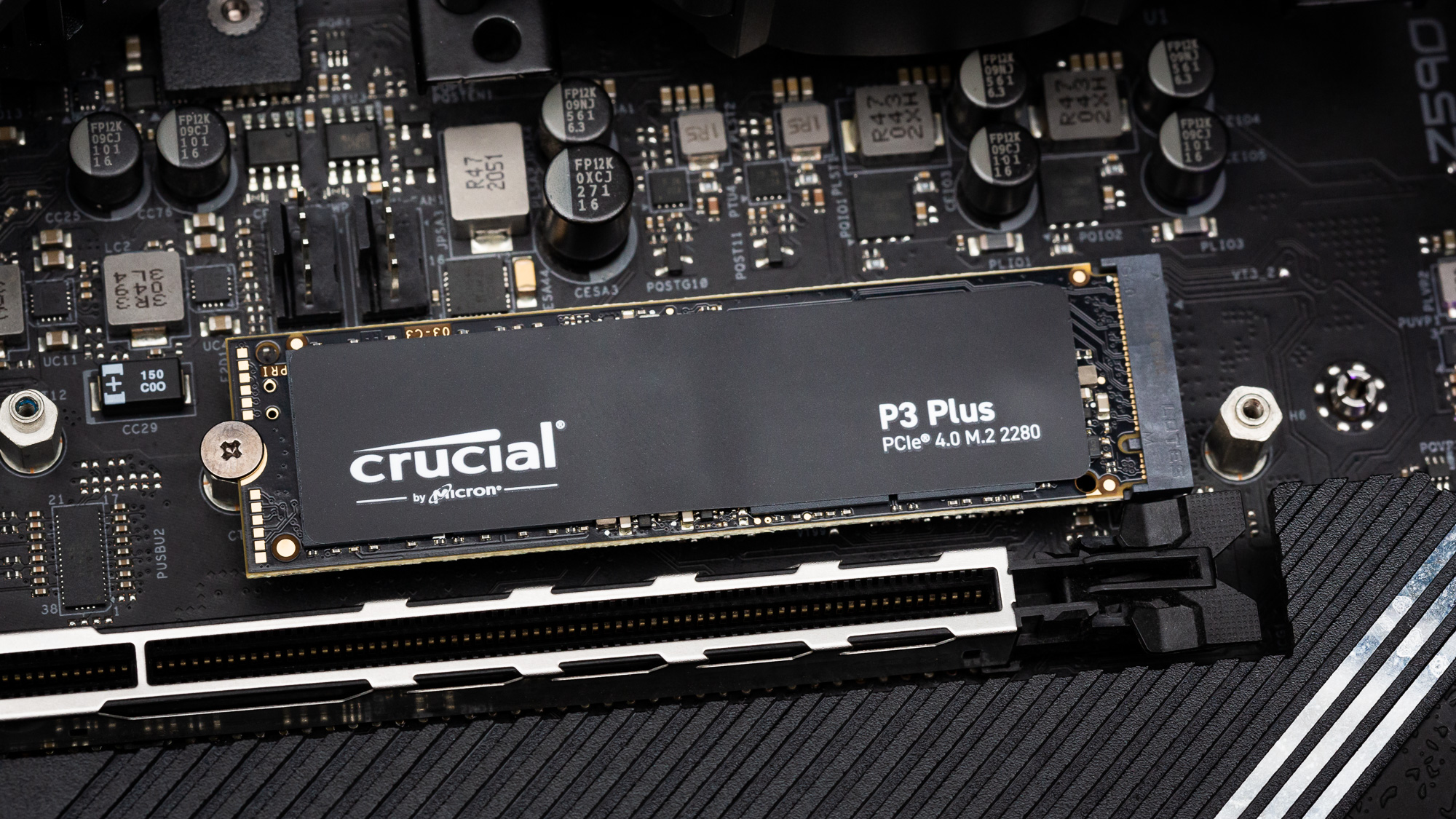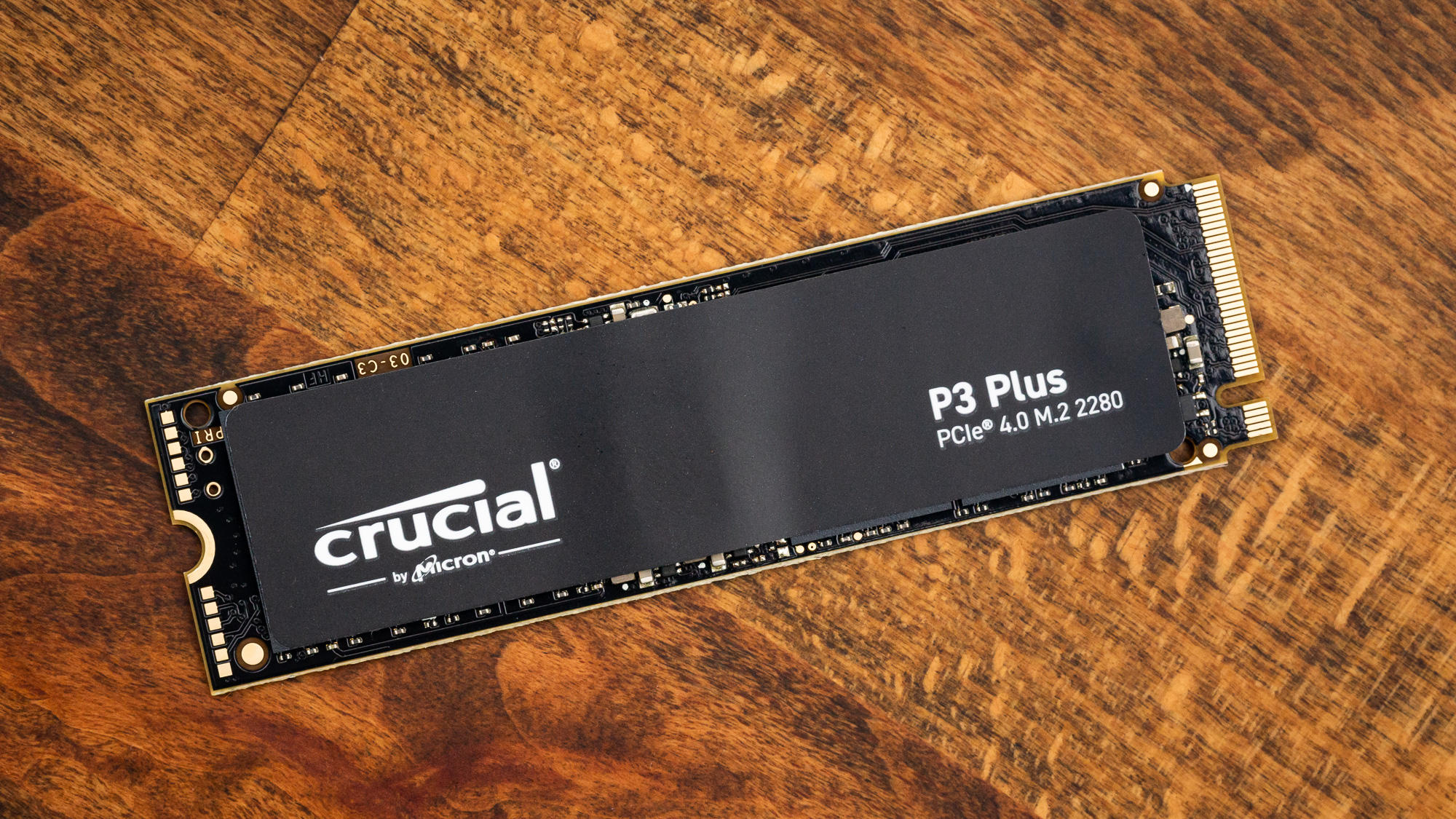Why you can trust Tom's Hardware
Comparison Products
It’s difficult to slot this drive into a performance category as there is little direct QLC competition in this space at this time. While there are some QLC drives built around the Phison E16 controller, like the Mushkin Delta, they are generally obsolete. We have chosen such a drive with TLC, the Sabrent Rocket NVMe 4.0, instead, as that type of drive has been popular for baseline usage in the PlayStation 5 (PS5). Intel’s 670p has some similarities, but with the formation of Solidigm and the announcement of its P41 Plus successor, it is probably on the way out.
However, it’s reasonable to see how this fares against popular PCIe 3.0 drives like the Crucial P5 and especially the SK hynix Gold P31. You may still have a 3.0 platform and want to know if it’s worth jumping up. Also included is the entry-level PCIe 4.0 drive, the Adata S50 Lite; it’s been a popular 2TB gaming drive. Crucial’s P5 Plus and SK hynix’s Platinum P41 help round out the high-end. In direct comparison will be WD’s SN770, which impressed us. Drives built on the IG5220 and E21T controllers are competitors, however they generally are limited in capacity - for example, with the UD90 topping out at 1TB in the U.S. for now.
Trace Testing - 3DMark Storage Benchmark
Built for gamers, 3DMark’s Storage Benchmark focuses on real-world gaming performance. Each round in this benchmark stresses storage based on gaming activities including loading games, saving progress, installing game files, and recording gameplay video streams.

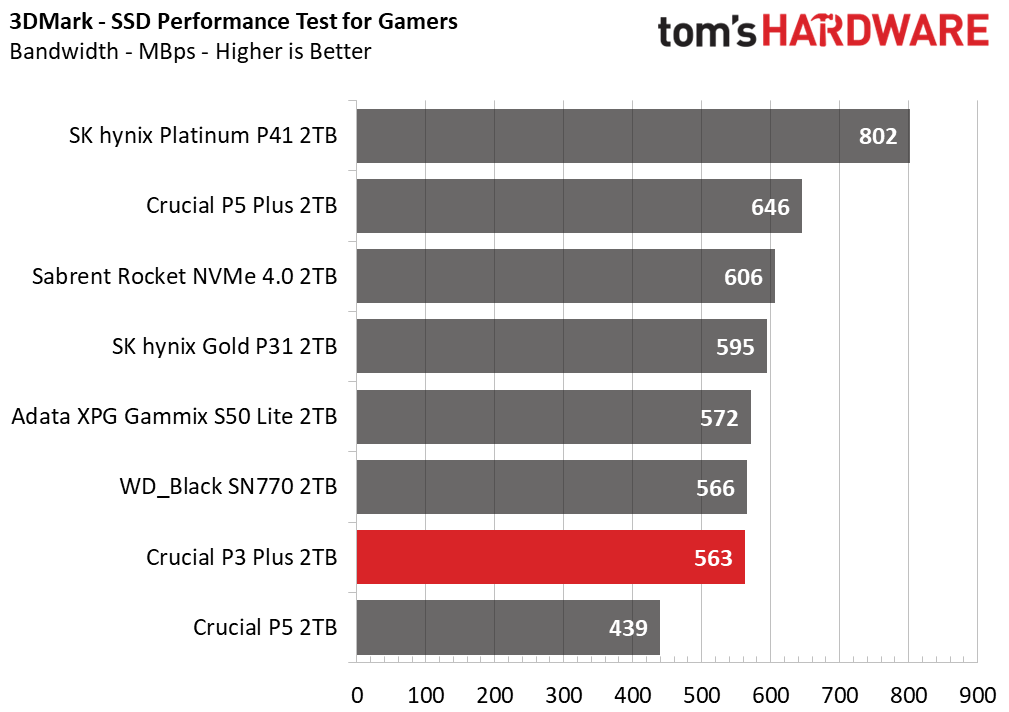
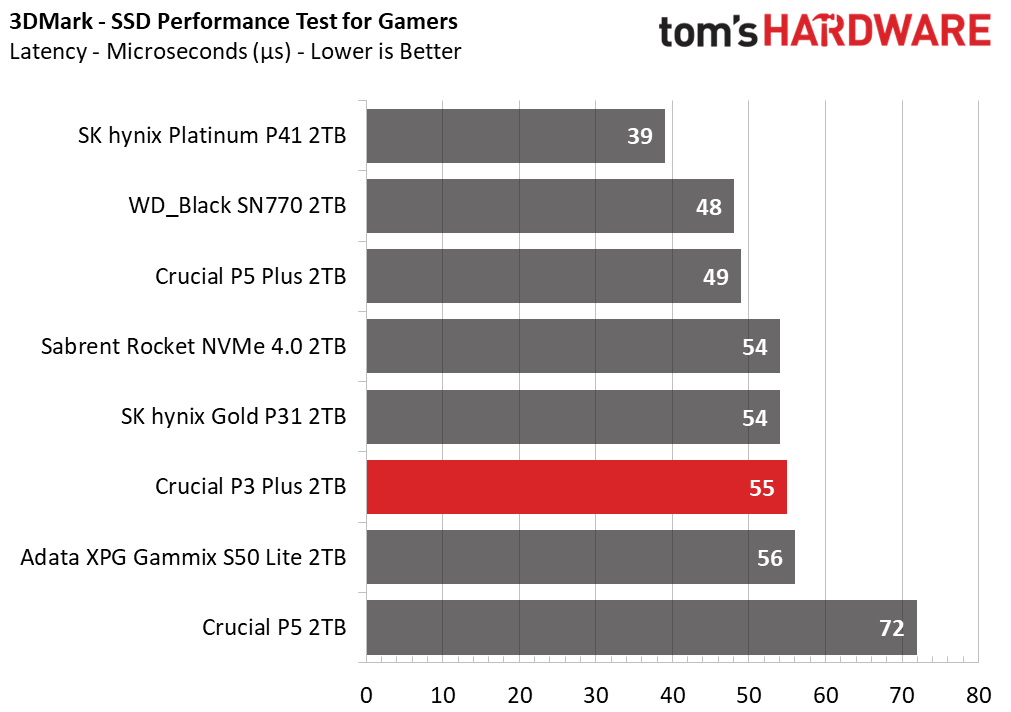
The P3 Plus is near the bottom of the pack, here, losing even to the PCIe 3.0 Gold P31. Nevertheless, it beats the P5 and isn’t too far off from being average.
Trace Testing – PCMark 10 Storage Benchmark
PCMark 10 is a trace-based benchmark that uses a wide-ranging set of real-world traces from popular applications and everyday tasks to measure the performance of storage devices.
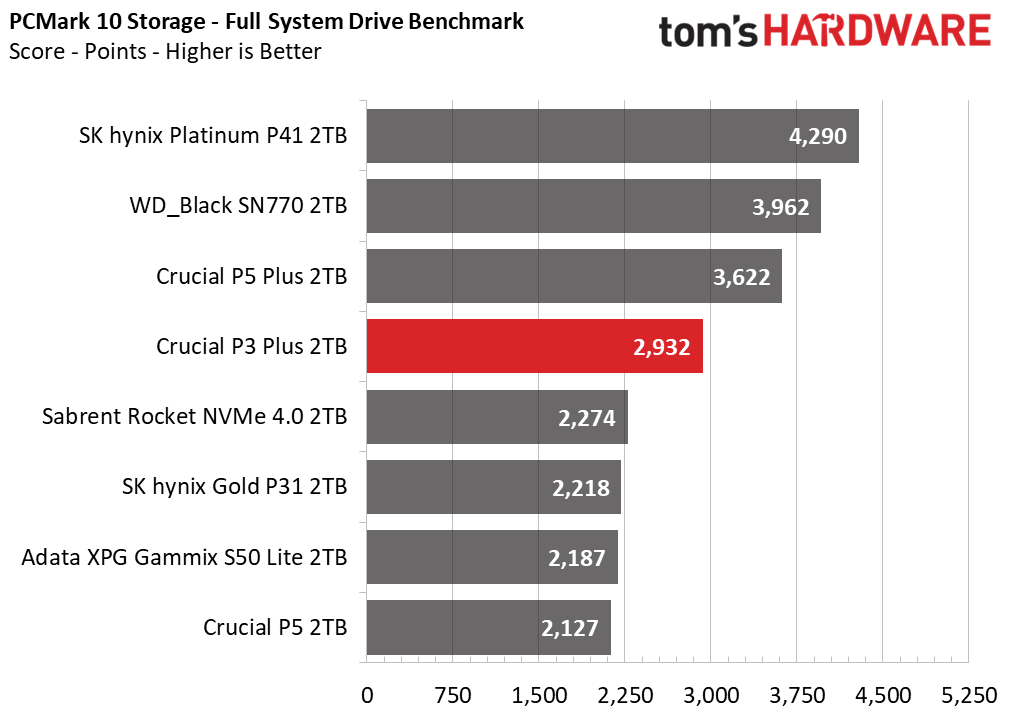
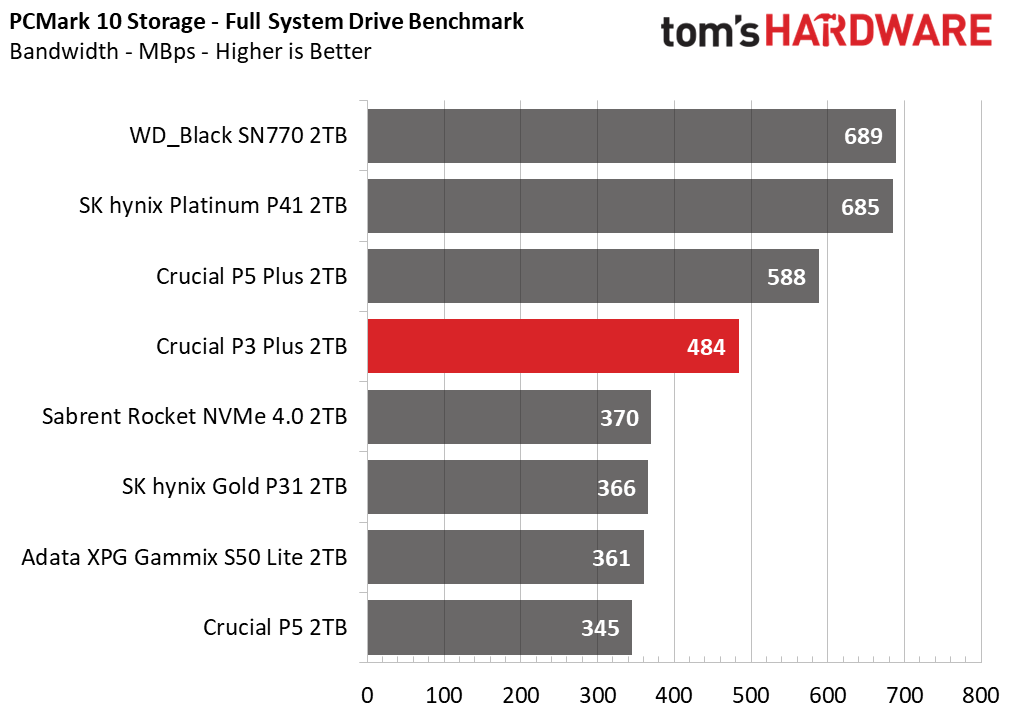
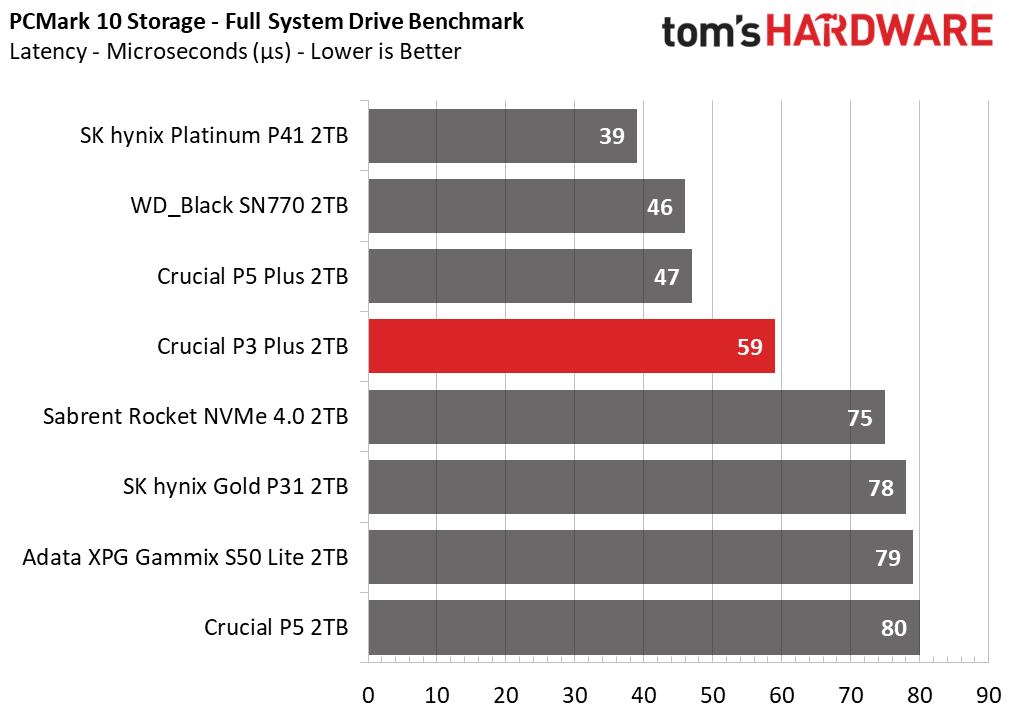
There are better results here as the P3 Plus benefits from a newer controller and newer flash. It can’t hang with the high-end PCIe 4.0 drives but is an improvement over older options. The SN770, which reviewed excellently, is also a cut above.
Transfer Rates – DiskBench
We use the DiskBench storage benchmarking tool to test file transfer performance with a custom, 50GB dataset. We copy 31,227 files of various types, such as pictures, PDFs, and videos to a new folder and then follow-up with a reading test of a newly-written 6.5GB zip file.
Get Tom's Hardware's best news and in-depth reviews, straight to your inbox.

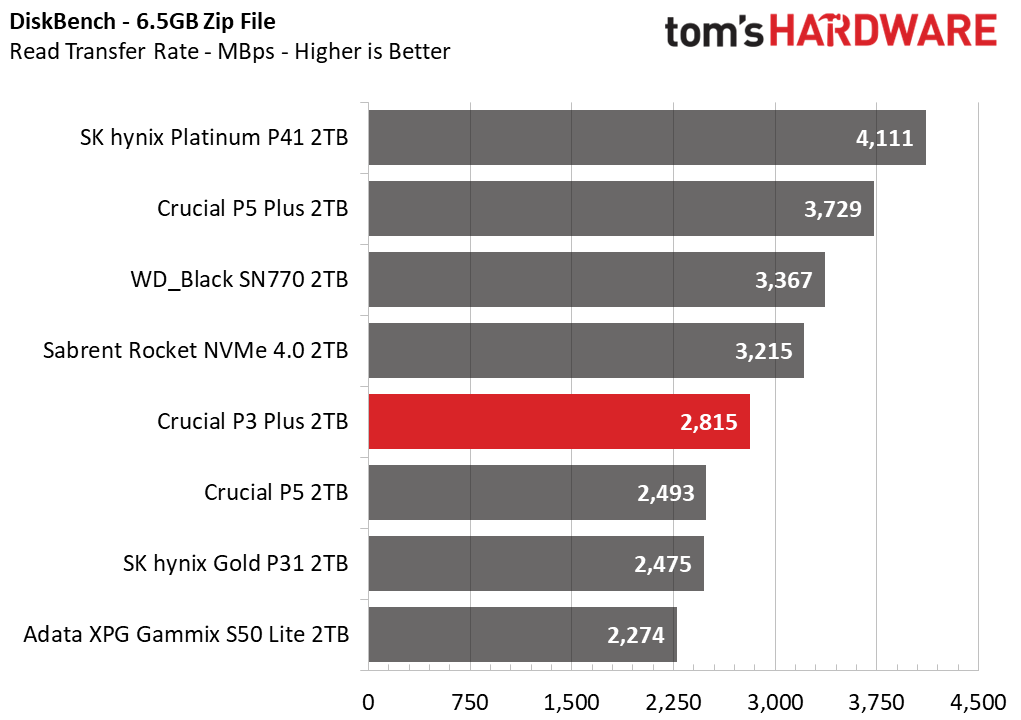
The PCIe 4.0 interface allows the P3 Plus to pull away from the PCIe 3.0 drives as well as the slower S50 Lite. It also beats the Rocket NVMe 4.0 with copying thanks to better write performance. This is impressive as the Rocket is eight-channel with TLC, not to mention that it has DRAM. However, the Phison E16 controller is limited and DRAM doesn’t directly assist with this type of workload.
Synthetic Testing - CrystalDiskMark
CrystalDiskMark (CDM) is a free and easy-to-use storage benchmarking tool that SSD vendors commonly use to assign performance specifications to their products. This tool gives us insight into how each device handles different file sizes.
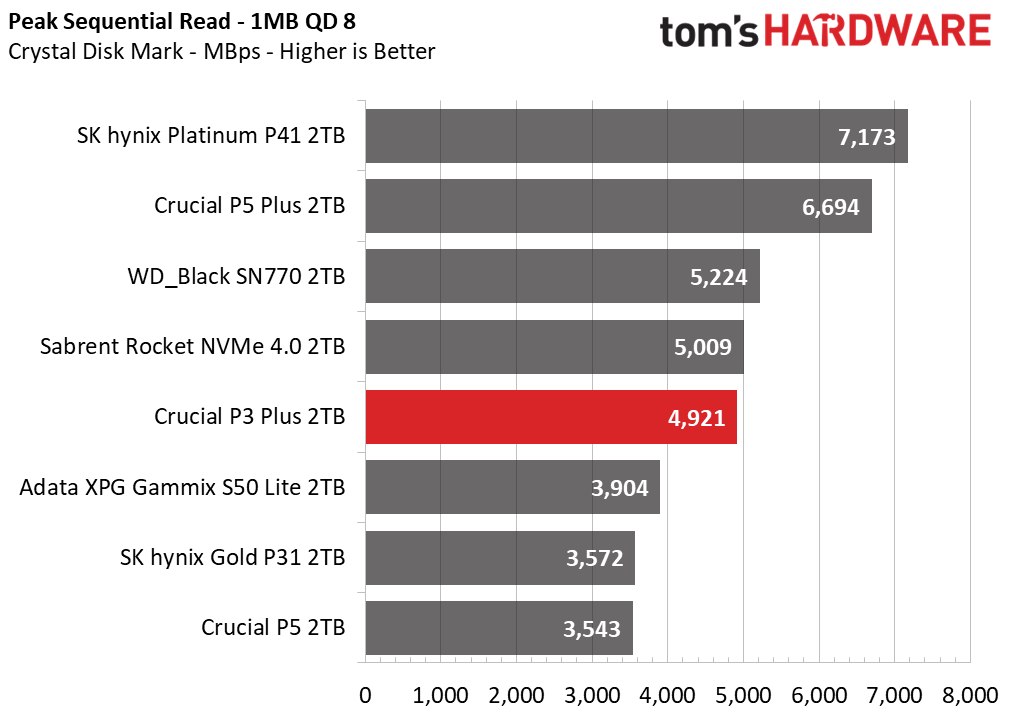
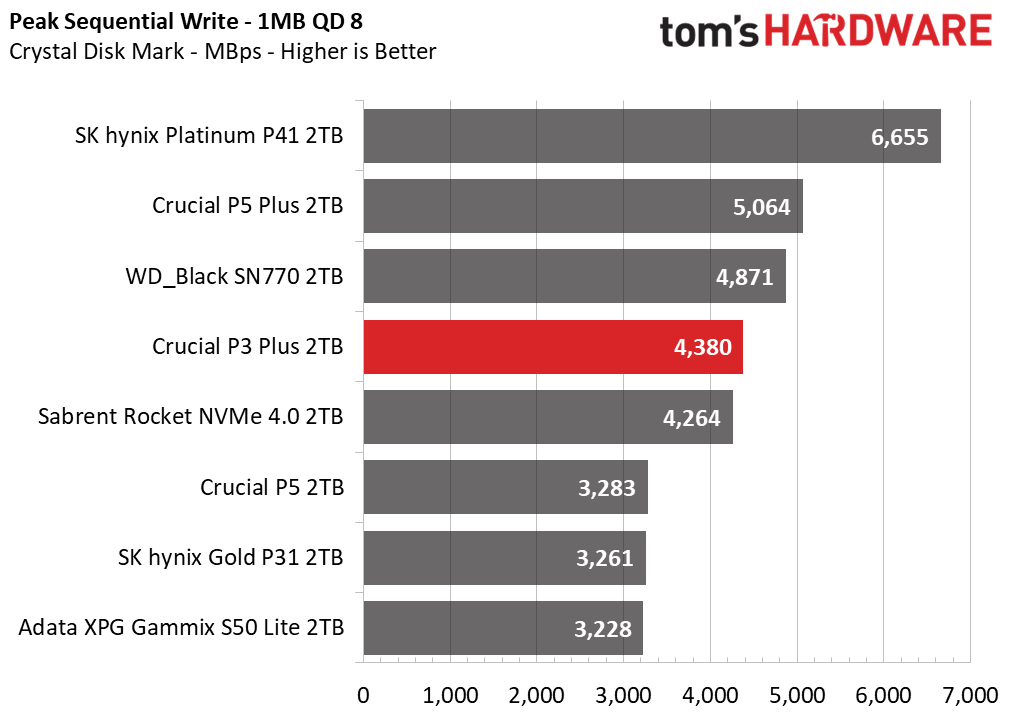
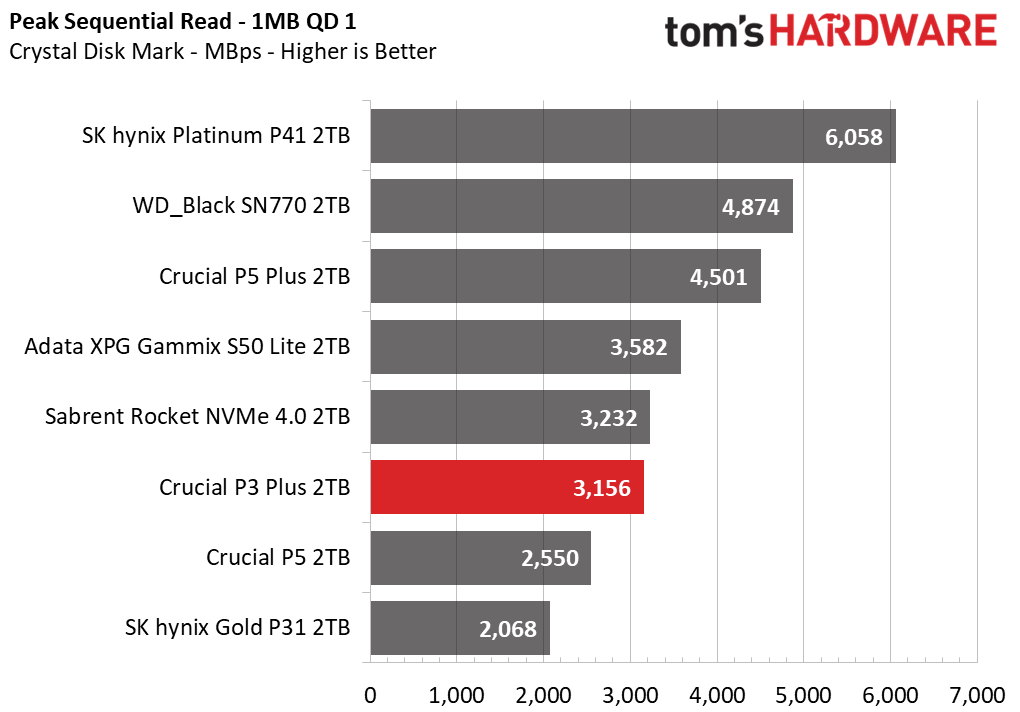

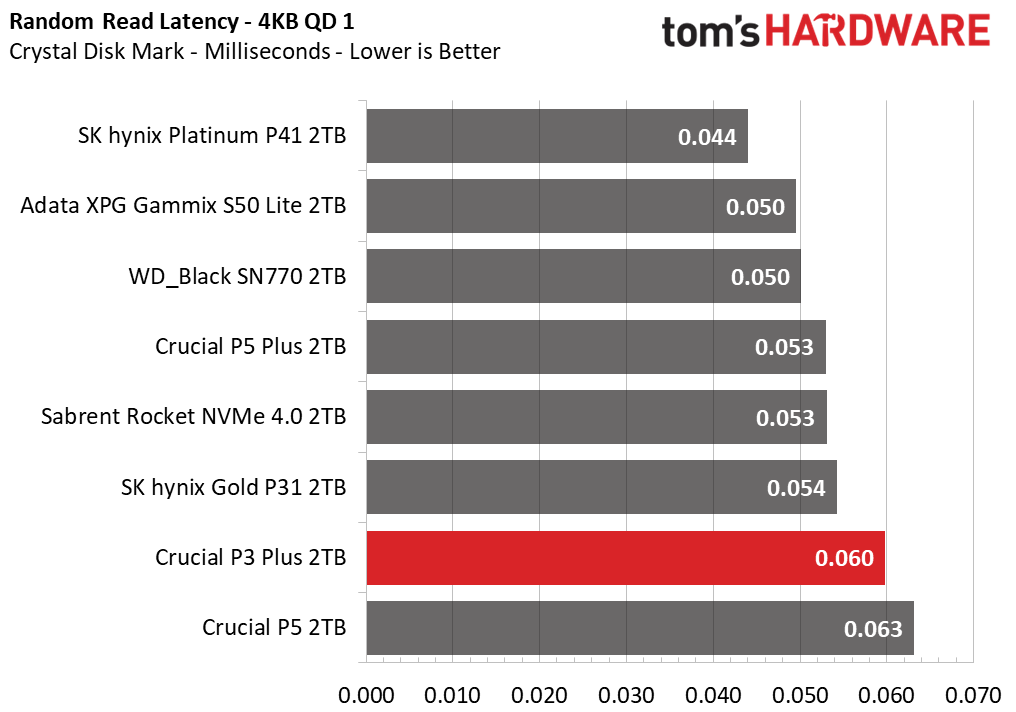
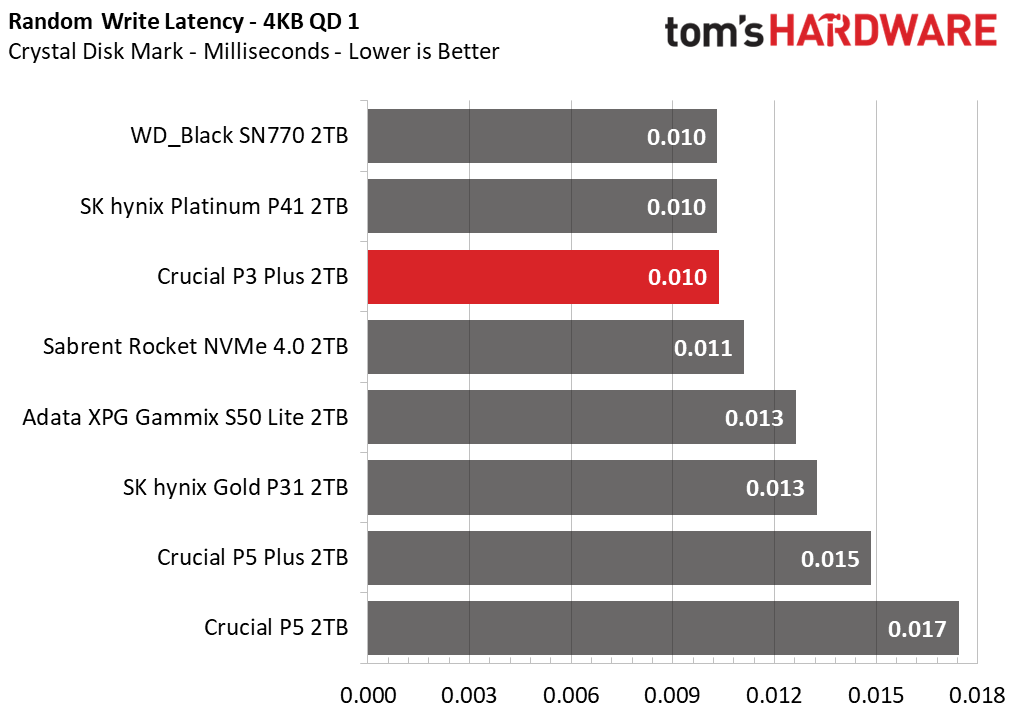
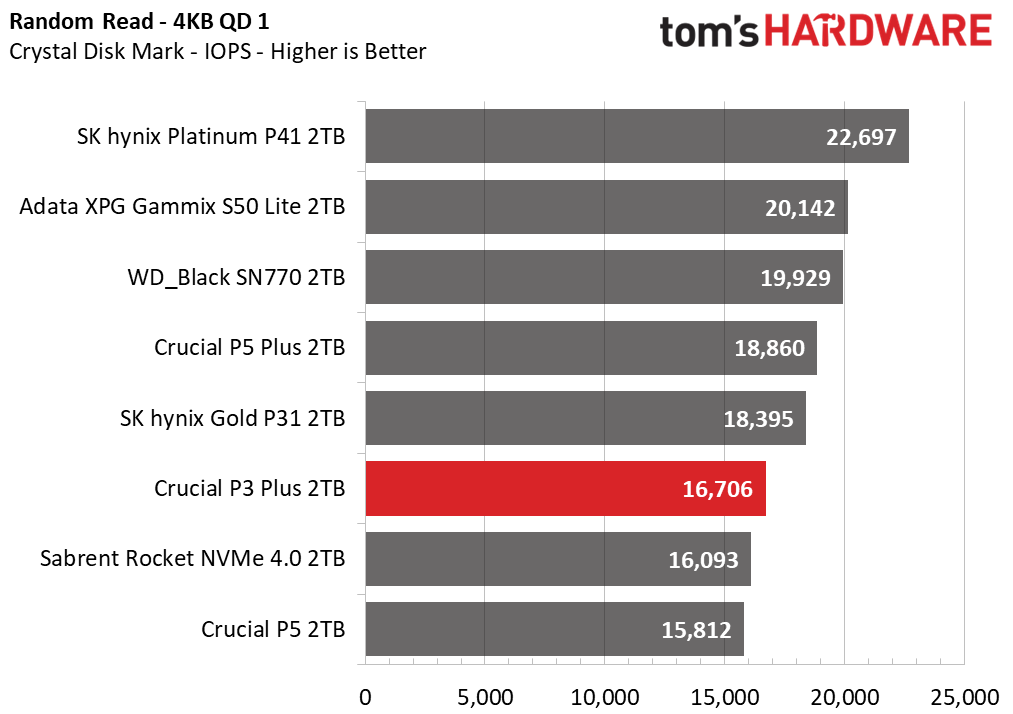
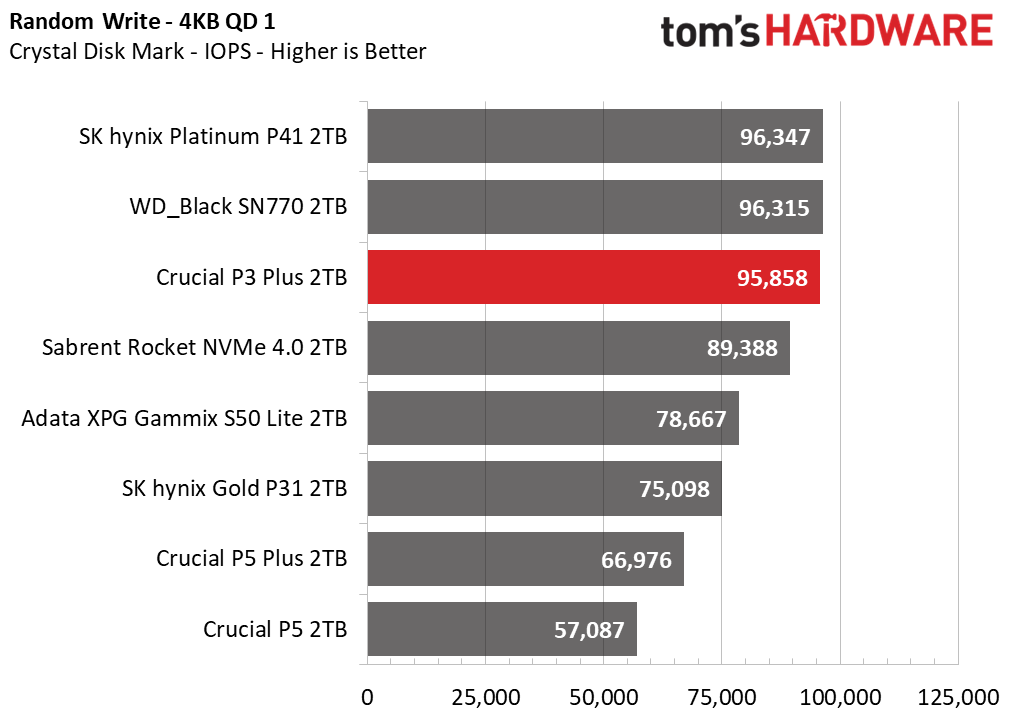

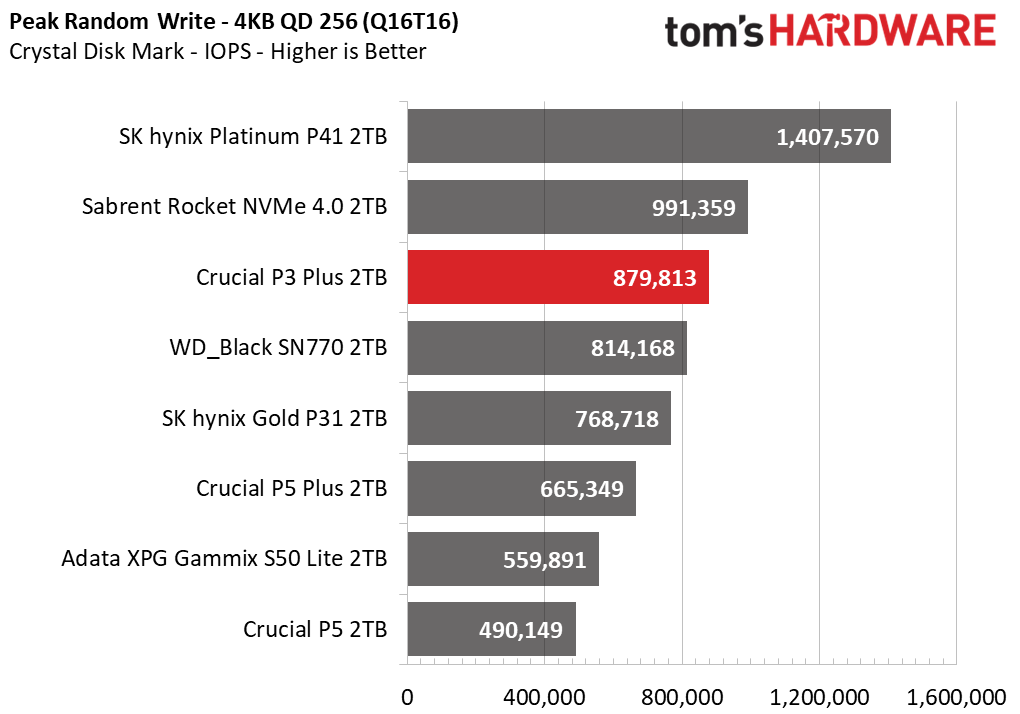
Looking first at sequential performance, the P3 Plus falls somewhere within the middle of the tested drives. It actually performs quite close to the Sabrent Rocket NVMe 4.0. This is noteworthy because newer, mid-range PCIe 4.0 drives are using four-channel DRAM-less controllers that can clearly match or exceed the Phison E16. Raw bandwidth is limited by the interface and we now have much more efficient drives - including the P3 Plus, using cheaper QLC - that can bring the same numbers.
Small I/O, or 4KB, performance is often more relevant for daily usage. Here the P3 Plus stumbles a bit with reads, but it’s still better than the P5 and Rocket NVMe 4.0. Its write performance is actually surprisingly good. Pseudo-SLC is such that, with modern flash, write performance can be quite strong with QLC, particularly with random writes, as die density is no real limitation.
However, as we mentioned above when looking at the NAND packages, Micron and other flash manufacturers have gone to great pains to improve random read performance with QLC. These improvements largely focus on multi-planar reads which particularly benefit from higher queue depths.
It is unsurprising that the P3 Plus does quite well at QD256 with 4KB random reads. Maximum IOPS may not be a realistic metric, at least while we wait on DirectStorage, but the results demonstrate that new hardware is easily surpassing the old.
Sustained Write Performance and Cache Recovery
Official write specifications are only part of the performance picture. Most SSDs implement a write cache, which is a fast area of (usually) pseudo-SLC programmed flash that absorbs incoming data.
Sustained write speeds can suffer tremendously once the workload spills outside of the cache and into the "native" TLC or QLC flash. We use Iometer to hammer the SSD with sequential writes for 15 minutes to measure both the size of the write cache and performance after the cache is saturated. We also monitor cache recovery via multiple idle rounds.
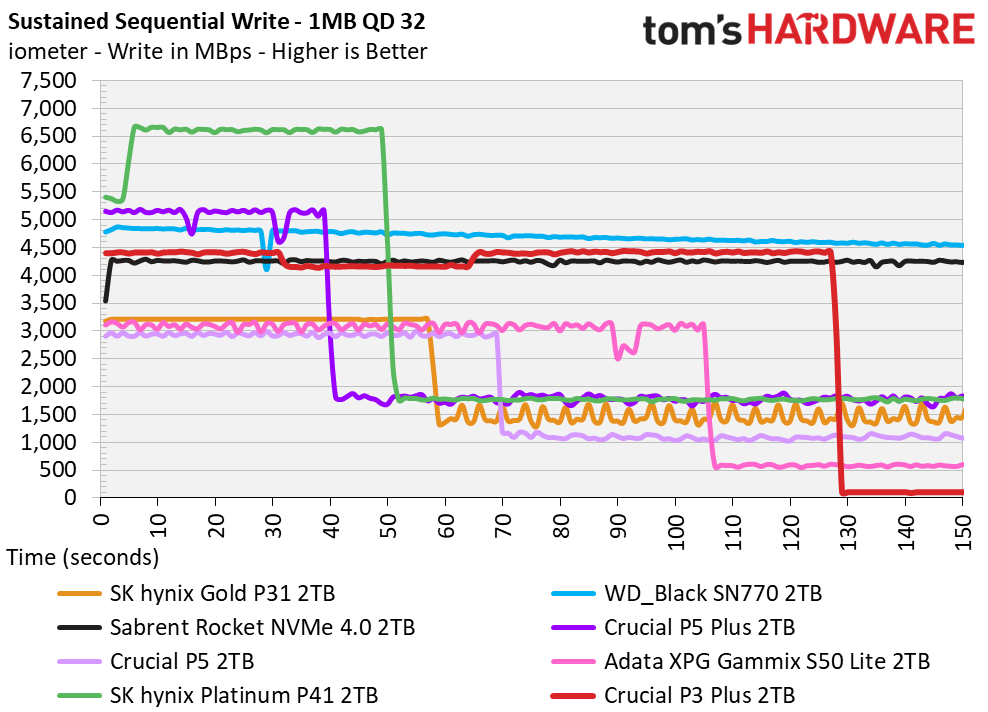




The good news is, the P3 Plus can absorb up to about 550GB of writes within its pSLC cache. This indicates that all of the QLC is capable of acting in single-bit mode for a total cache capacity that’s one-fourth of the flash. This cache will diminish in size proportionately as the drive is filled based on how much space is left free. A large, dynamic cache is a good way to hide weak native performance. The P3 Plus’s cache is ample to handle typical, bursty workloads.
The bad news is that the native performance is extremely poor. Speeds drop down from 4.4 GBps to 100 MBps. We know that this flash is about as fast as Intel’s 144-layer QLC, that is up to 40 MBps per die, but the use of a massive cache forces the drive to bottleneck as it must free up capacity by moving data over to QLC. The 670p has some static cache and also DRAM, so it doesn’t suffer quite as much. Within the compared drives we do see weak post-cache performance from the SN770, Rocket NVMe 4.0, and SN770 as well.
On the bright side, the P3 Plus is very good at recovering its pSLC cache given sufficient idle time. Leaving some data in the cache can be beneficial for future reads on newly-written data. In fact, this is a tactic utilized by the upcoming P41 Plus when it’s less full, although that discussion is to be left for another time. With the P3 Plus it does seem that Crucial tries to strike a reasonable balance but it’s definitely not as consistent as drives with TLC.
Power Consumption and Temperature
We use the Quarch HD Programmable Power Module to gain a deeper understanding of power characteristics. Idle power consumption is an important aspect to consider, especially if you're looking for a laptop upgrade as even the best ultrabooks can have mediocre storage.
Some SSDs can consume watts of power at idle while better-suited ones sip just milliwatts. Average workload power consumption and max consumption are two other aspects of power consumption, but performance-per-watt is more important. A drive might consume more power during any given workload, but accomplishing a task faster allows the drive to drop into an idle state more quickly, ultimately saving energy.
We also monitor the drive’s temperature via the S.M.A.R.T. data and an IR thermometer to see when (or if) thermal throttling kicks in and how it impacts performance. Remember that results will vary based on the workload and ambient air temperature.
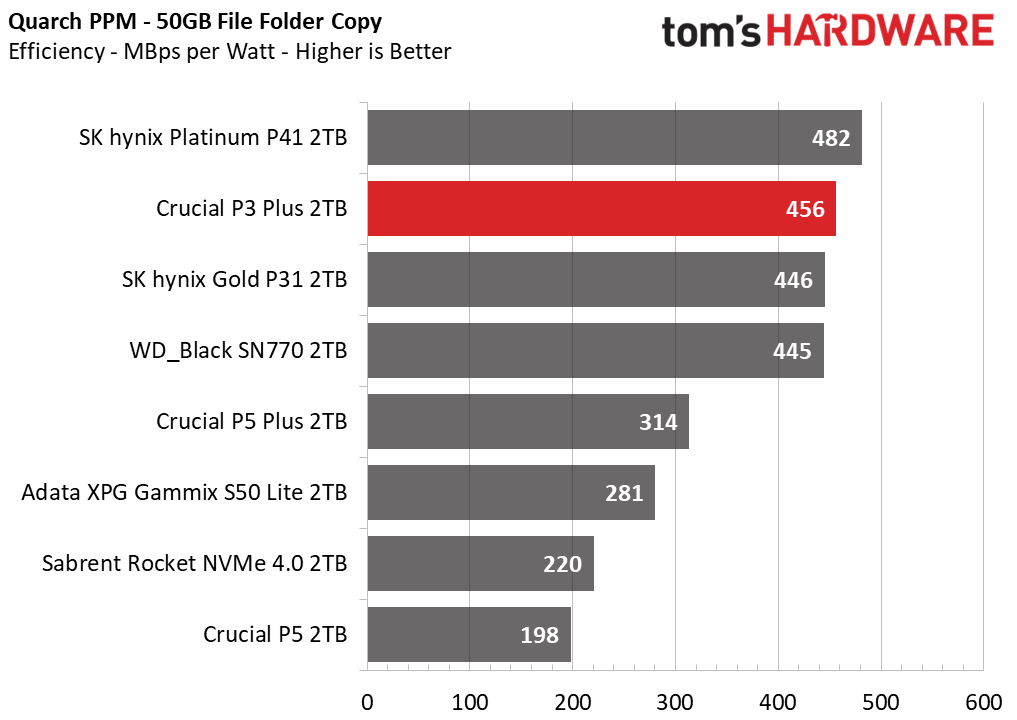
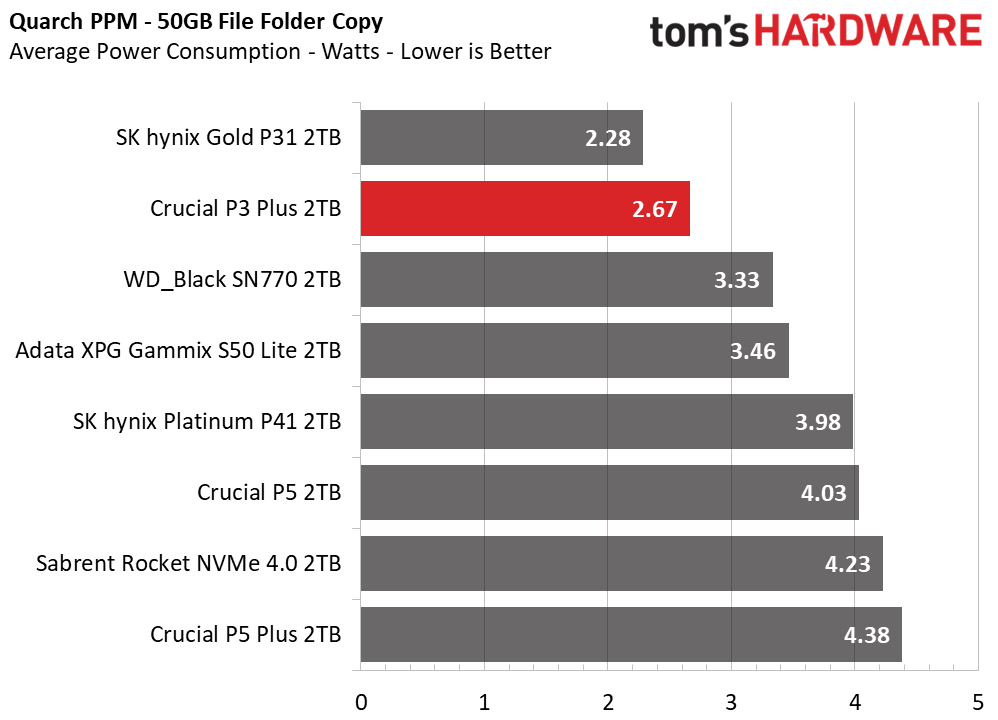
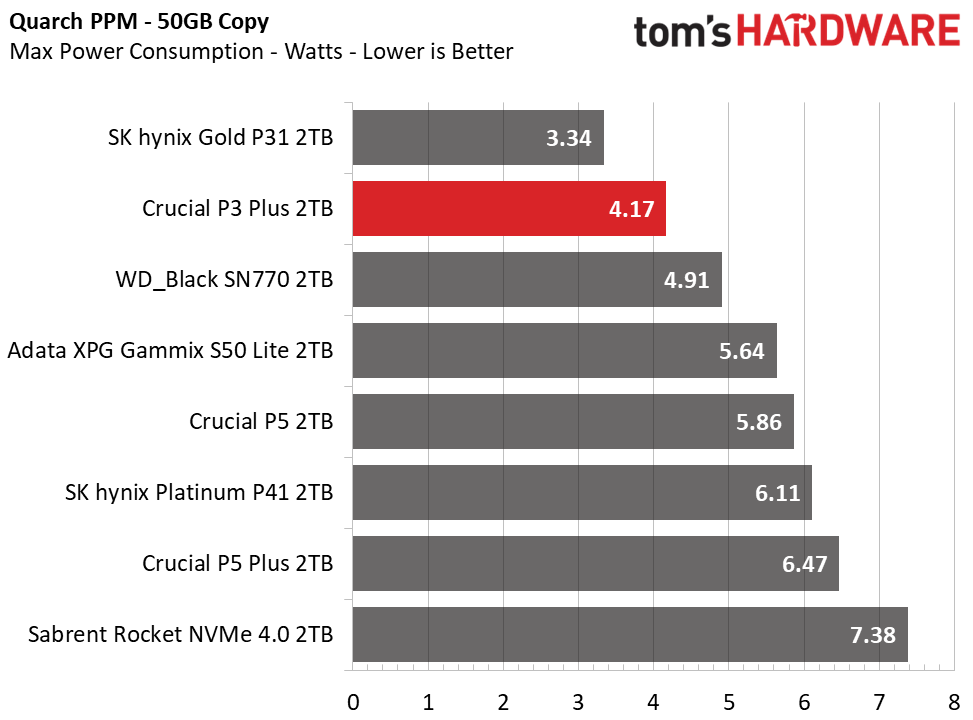
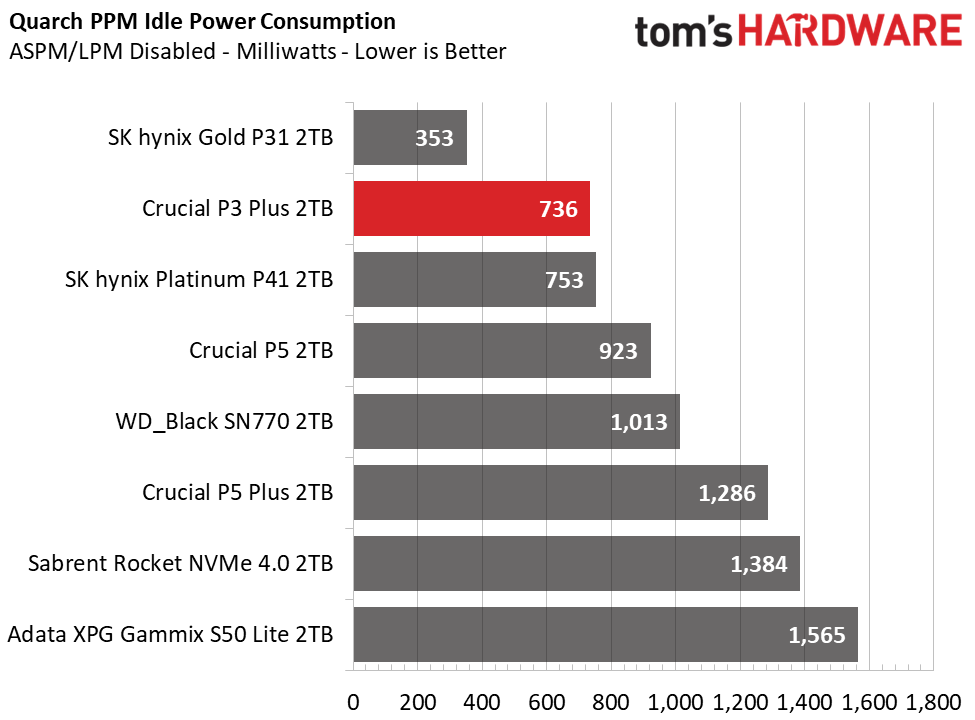
The P3 Plus is quite efficient, as we would expect from its hardware. It falls in-between the Gold P31 and Platinum P41, two drives from SK hynix known for their high power efficiency. Contemporary mid-range PCIe 4.0 drives tend to do well here as they have four-channel controllers without DRAM. This enables them to transfer data rapidly with low maximum power draw. This drive would be a popular choice for laptops especially as such machines are often limited to just one or two M.2 slots, so capacity is at a premium.
The P3 Plus idled at 37C by measurement and 40C through SMART. We pushed the drive hard by writing through all of the SLC, but it refused to throttle. The drive only hit 63C under load. This is a testament to its efficiency - for the controller, the flash, and the layout. These temperatures also reinforce the P3 Plus’s status as a good choice for laptops and consoles.
Test Bench and Testing Notes
| CPU | Intel Core i9-11900K |
| Motherboard | ASRock Z590 Taichi |
| Memory | 2x8GB Kingston HyperX Predator DDR4 5333 |
| Graphics | Intel UHD Graphics 750 |
| CPU Cooling | Alphacool Eissturm Hurricane Copper 45 3x140mm |
| Case | Streacom BC1 Open Benchtable |
| Power Supply | Corsair SF750 Platinum |
| OS Storage | WD_Black SN850 2TB |
| Operating System | Windows 10 Pro 64-bit 20H2 |
We use a Rocket Lake platform with most background applications such as indexing, Windows updates, and anti-virus disabled in the OS to reduce run-to-run variability. Each SSD is prefilled to 50% capacity and tested as a secondary device. Unless noted, we use active cooling for all SSDs.
Conclusion
The P3 and P3 Plus SSDs are PCIe 3.0 and 4.0 successors, respectively, to the Crucial P2. We were not fans of the P2, especially when Crucial later switched to QLC from TLC. However, we imagine it probably sold well due to its availability, pricing, and varied capacity options.
With the new drives Crucial has opted for improved controllers and QLC flash. The goal is still the same - to offer enticing budget drives that cover a wide area, but also excel in a niche. This is why Crucial offers both from 500GB to 4TB.
The P3 Plus is pitted against an array of excellent budget 4.0 drives, such as the FX900, the P400, the UD90, and the SN770. It stands out by offering higher capacities and potentially lower GB/$ sale prices. TLC offers higher performance in some cases, mostly edge, and also higher TBW. Warrantied write endurance tends not to be a big issue for SSDs, particularly budget ones. That being said, be aware that future drives - like Solidigm’s P41 Plus - could offer a more well-rounded package with QLC at a similar price.
The P3 Plus performed surprisingly well, buoyed by its aggressively large SLC cache and many improvements to the QLC flash. Newer DRAM-less drives simply blow the old technology out of the water, which doesn’t hurt either. The drive is also incredibly efficient and cool-running which puts it in a good spot for laptops and the PS5. The warranty period is a solid five years and Crucial has sufficient software support. All of this is good news, particularly if you’re looking for an affordable 4TB SSD.
That being said, the P3 Plus is still powered by QLC which has its shortcomings. It’s not going to set records with low queue depth reads or with sustained writes. In fact, the native QLC performance is quite poor. We didn’t expect the drive to match the Platinum P41, but realistically it’s also going to struggle against its direct TLC peers in some rare cases. On the whole it is decidedly average, but all of this can be overlooked if it’s priced right - and especially if you need capacity that won’t break the bank.
MORE: Best SSDs
MORE: How We Test HDDs And SSDs
MORE: All SSD Content

Shane Downing is a Freelance Reviewer for Tom’s Hardware US, covering consumer storage hardware.
-
cyrusfox This is impressive, is anyone else achieving QLC on charge trap NAND yet? 220 cycles is respectable for a first attempt.Reply
As far as I know this is the first charge trap QLC ssd on the market. Microns old QLC drives and NAND(Which they sell to Rocket and others) were all based on Floating Gate NAND they co-developed with Intel now Solidigm which Hynix bought from Intel (Solidigm , lame name). Micron's old QLC SSD drive was essentially identical to Intel's 660p or 665p(Identical NAND, different controller tuning). Solidgm is the only NAND manufacturer still utilizing charge trap storage which appears to have an inherrent advantage at multiple charge states per cell compared to charge trap which the other NAND makers are utilizing (Samsung, Hynix, Micron). This is supported by Solidigm being the first to show off PLC tech based on floating gate. With charge trap successfully making it to market with QLC it's still in the race for adding addition bits per cell but likely 2-3 years behind (based on the first qlc drive which came out 2019 - Intel 660p). -
Albert.Thomas Replycknobman said:IMO the cost savings is not worth the tradeoff of reduced performance and endurance.
The reduced performance doesn't bother me, the price of these SSDs is very attractive.
However, the reduced endurance guarantees does have me a little worried. -
escksu ReplyAlbert.Thomas said:The reduced performance doesn't bother me, the price of these SSDs is very attractive.
However, the reduced endurance guarantees does have me a little worried.
200TBW is still decent because most end users do not overwrite their drives that many times (if you do, you need a bigger drive).
But the cost $189 for 2TB. You can find many TLC drives at that price range too. -
escksu Replyjackt said:random write is as good as skhynks p41 ! but random read is slow !
The write is good because of the huge SLC cache. But you need a big drive to have a big cache -
Albert.Thomas Replyjackt said:random write is as good as skhynks p41 ! but random read is slow !
I've tested this drive myself, the write performance of the P3 Plus is incredible.
The read performance is reflective of it's budget price, however.
